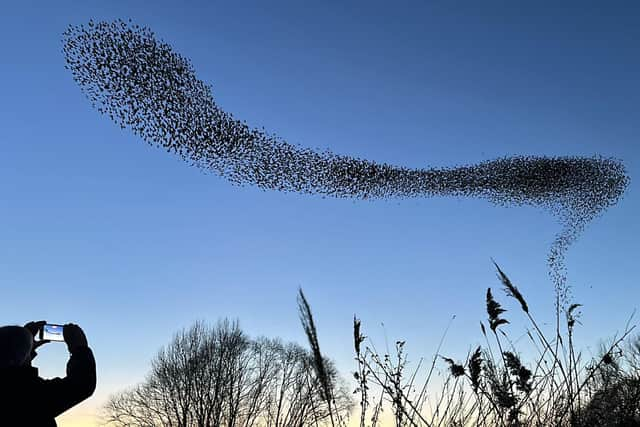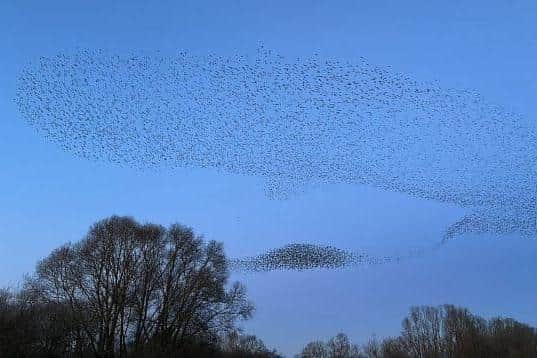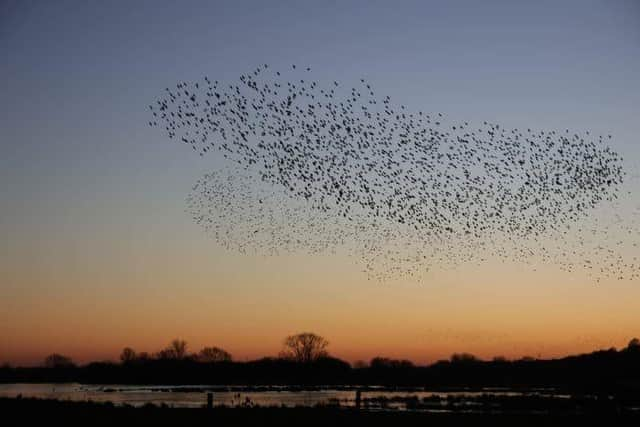Watch natural phenomenon of murmurations in the skies over Stanwick Lakes
and live on Freeview channel 276
The skies over Stanwick Lakes are currently the stage for a natural phenomenon, leaving visitors and rangers feeling incredibly lucky if they witness one of these magical murmurations.
The nature reserve observed significant starling numbers and some murmurations in January and expects to see more this month and next.
Advertisement
Hide AdAdvertisement
Hide AdCovering 750 acres, the wetland site provides an ideal habitat for starlings to roost and perform.


Stanwick Lakes ranger Michelle said: “Having worked in conservation in some incredible places throughout the UK and beyond, I’ve been lucky enough to see some magnificent wildlife.
"Throughout though, a starling murmuration has always been irrefutably at the top of my wildlife list.
"To be able to see such a spectacle on our doorstep is magical and I feel unbelievably lucky to work at Stanwick Lakes to see this.”
Advertisement
Hide AdAdvertisement
Hide AdStarling murmurations occur when large flocks of these birds swoop and swirl together in an intricate dance before settling into their evening roost.


There is no definite answer as to why these birds behave in this way, but many experts say it might be a tactic to deter and discombobulate predators, gaining safety in numbers, and to stay warm.
And murmurations can be spontaneous and unpredictable, meaning there is no guarantee of their occurrence.
Murmurations usually occur between the months of November and March, at dawn and dusk, with Stanwick Lakes inviting visitors to help them keep track and document any sightings.
Advertisement
Hide AdAdvertisement
Hide AdRanger Issac said: “Getting to capture magical moments in nature is such a gift that my job here has made possible every day.


"Documenting the work we do as rangers and moments like these is one of the many ways I can help engage visitors with the natural world around them.
"We are truly so very lucky to have experiences like these here at Stanwick Lakes and what once seemed like ‘once in a lifetime’ spectacles are now something I get to be a part of regularly at work.”
Local birders have been monitoring the murmuration, estimating a presence of around 20,000 starlings.
Advertisement
Hide AdAdvertisement
Hide AdBut this dance in the skies is not limited to starlings - once a gathering builds, it can disturb crows, jackdaws, and even the lapwings at Stanwick Lakes.
Birds of prey including peregrines, sparrow hawks and occasionally harriers can also be drawn in by the commotion.
Rangers say the murmurations at Stanwick Lakes so far seem haphazard, sometimes scattered and unpredictable.
They have been seen flying along the water’s surface and close to the ground, and due to the low flight path, they can be difficult to see and may even go unnoticed at times.
Advertisement
Hide AdAdvertisement
Hide AdWhile the birds do gather for roosting each evening, they may do so in numerous smaller groups, and in different locations.
Displays can build in numbers and movement gradually so visitors are advised to be patient.
The rangers would love to hear from any visitors who catch sightings of starlings, and in particular murmurations so that they can add them to a ‘murmuration map.’
They are also looking for any photos you are happy to share for a ‘Starling Scrapbook.’
Anyone with details of sightings, pictures or video can leave details of your observations at the visitor centre, email Stanwick Lakes or @mention Stanwick Lakes on social media.